



The Kashmir Valley also known as “pir waer”, the garden of saints has a rich and vibrant spiritual history visible in the form of shrines built by followers of Muslim saints.
The Sufi shrines peppered across Kashmir add to the picturesque beauty of the Valley. The holy shrines, also known as “Dargahs”, built in memory of saints, present splendid architectural work and have been centres of devotion, learning, festivals and spiritual gatherings that have inspired generations.
Every day hundreds and thousands of worshippers throng these Sufi shrines, mostly built by medieval rulers in Kashmir. People offer congregational prayers while tourists also visit these shrines. Inside these shrines, visitors get to see the calligraphy, painting, Khatambandh woodwork and papier-mâché.
One can spot almost all Kashmir’s important Sufi shrines in Srinagar city but there are a number of important shrines located outside. Some shrines are located on the top of the hills because Central Asian Muslim saints, who settled in the Valley, found enough isolation to pray, meditate and worship the Almighty on hills.
In June, this year Jammu and Kashmir’s Lieutenant Governor Manoj Sinha had called for the revival of 'shrine tourism or pilgrimage tourism in Kashmir'. Sinha said, the way people from across the country go for the Amarnath Yatra, they can also come to see Sufi shrines in the Valley.
Here are 6 important Sufi shrines in the Kashmir Valley that you must visit:
Dargah Hazratbal
Hazratbal shrine situated on the western shore of Dal Lake in Srinagar is the most important Muslim religious place in the region.
Its pristine white marble elegance is reflected in the waters of the lake and the shrine is lived with the memory of the sacred hair of Prophet Muhammad. Hazratbal shrine is locally known as Dargah and is situated opposite the University of Kashmir main Campus. It is the only domed mosque in Srinagar city as all other mosques have pagoda-like roofs.
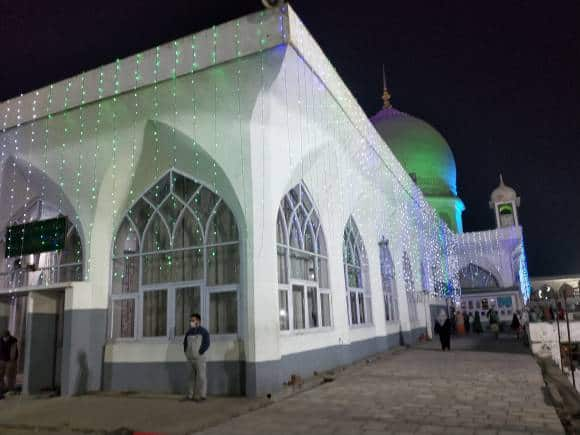 Dargah Hazratbal.
Dargah Hazratbal.
Emperor Shahjahan built the mosque in 1634 AD but the old structure was replaced by modern architecture in 1979 by the then chief minister Sheikh Mohammed Abdullah.
People who can not afford to go to Madina in Saudi Arabia come to Hazratbal and find solace while taking the glimpse of the sacred hair of the final Prophet of Islam.
Khanqah-e-Moula
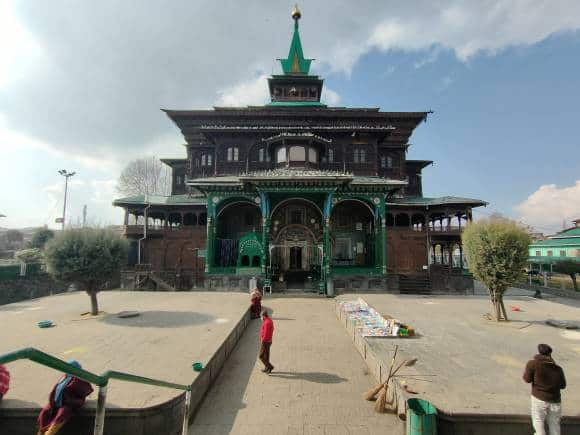 Khanqah-e-Moula.
Khanqah-e-Moula.
The mosque locally known as Khanqah is located in Srinagar’s old city and is situated by the river Jhelum which flows through the city.
The mosque which falls between Zaina Kadal and Fateh Kadal bridges was built after Persian Sufi mystic Amir-i-Kabir or Mir Syed Ali Hamdani (RA) from western Iran, who visited Kashmir thrice in the 1370s and 1380s accompanied by hundreds of disciples. After his death, the Khanqah-e-Moula was erected in his honour in the 1390s.
Khanqah has top notch wooden structure and incredibly painted interiors besides the delicately carved eaves and hanging bells. The antique chandeliers also give the building a grandeur look that is said to have been constructed without using any nails.
Mir Syed Ali Hamdani also known as Shah-e-Hamdan is said to have introduced the shawl workmanship craft in the Valley.
The shrine featured in the Vishal Bhardwaj film Haider (2014).
Charar-e-Sharief
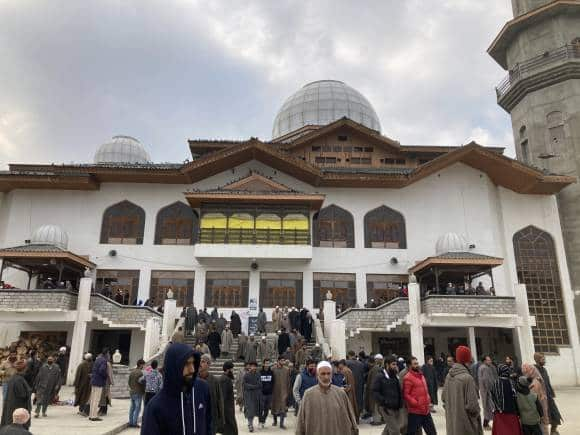 Charar-e-Sharief.
Charar-e-Sharief.
The tomb of Sheikh Noor-ud-Din Rishi in central Kashmir’s Budgam district is the most popular and revered Muslim Shrine in the Valley. The shrine is dedicated to Noorani locally known as Alamdar-e-Kashmir, the pioneer of the indigenous Sufi movement known as “Rishi movement”.
The shrine situated 28 km to the south-western side of Srinagar is also known among Muslims and non-Muslims alike by the Sanskrit name Nund Rishi (Nund the Sage). People from across Kashmir visit the shrine on Fridays to offer grand prayers and also during the annual urs (the death anniversary of a Sufi saint) to seek the blessings.
Despite the shrine being razed by a fire that broke out during an encounter between Indian Army and militants in 1995 it was rebuilt and continues to be a place of important pilgrimage, approximately 600 years old.
Dastgeer Sahib
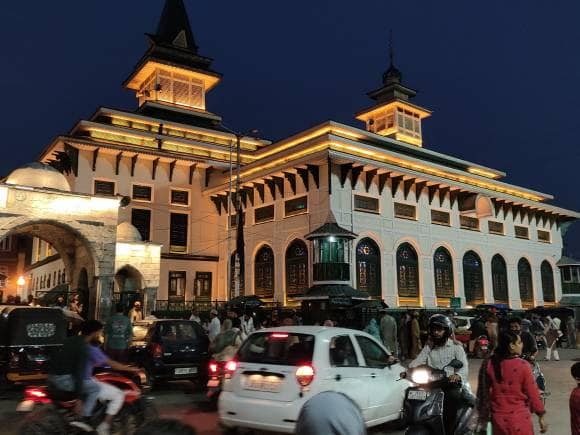 Dastgeer Sahib Khanyar.
Dastgeer Sahib Khanyar.
Situated in heart of Srinagar city in Khanyar area, the shrine is named after Sheikh Syed Abdul Qadir Jeelani popularly known as Dastgeer Sahib or “Gous-e-Azam”.
The shrine decorated with opulent papier-mâché work was built in memory and respect of “Gous-e-Azam” who never visited Kashmir and is buried in Iraqi capital Baghdad. The shrine houses an old Quran written by two very influential companions of Prophet Muhammad and a piece of holy hair of “Gous-e-Azam”.
The shrine, built around 200 years ago in Kashmir, was reduced to ashes in a mysterious fire incident in June 2012.
However, the new structure of the shrine was constructed almost on the same design to keep the memories of “Gous-e-Azam” alive. On the annual urs of Abdul Qadir, thousands of people from all over Kashmir assemble and have glimpses of the sacred relics of “Gous-e-Azam”.
Makhdoom Sahib
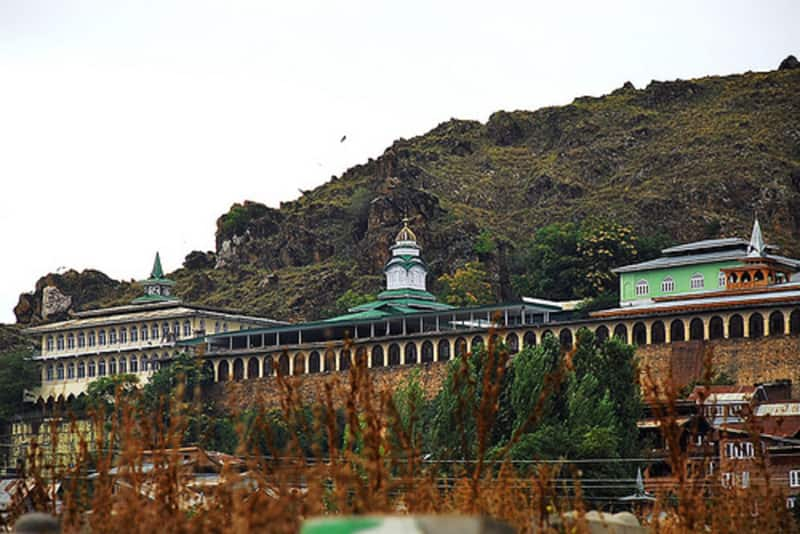 Sheikh Hamza Makhdum Sahib Shrine.
Sheikh Hamza Makhdum Sahib Shrine.
Dedicated to Sheikh Hamza Makhdhoomi the shrine locally known as Makhdoom Sahib is situated on the Koh-i-Maraan hills near the famous Hari Parbat fort in Srinagar. This shrine is named after Makhdoom, a Sufi mystic, scholar and spiritual teacher who was known as Mehboob-ul-Alam (lover of knowledge) and Sultan-ul-Arifeen (king of those who know God).
Born to Baba Usman Raina in Tujar Shareef, a village in Kashmir, in 1494 the Sufi saint greatly contributed in spreading religious and spiritual knowledge around the city.
There are around 80 stairs that devotees take to reach the shrine and pray. The shrine, 5 km away from Srinagar has a structure with many pillars, which is a rare example of Mughal architecture built by Mughal emperor Akbar.
Visitors including devotees and tourists who cannot climb the stairs also reach the shrine through ropeways which ferry more than 200 passengers per hour.
Aishmuqam Shrine
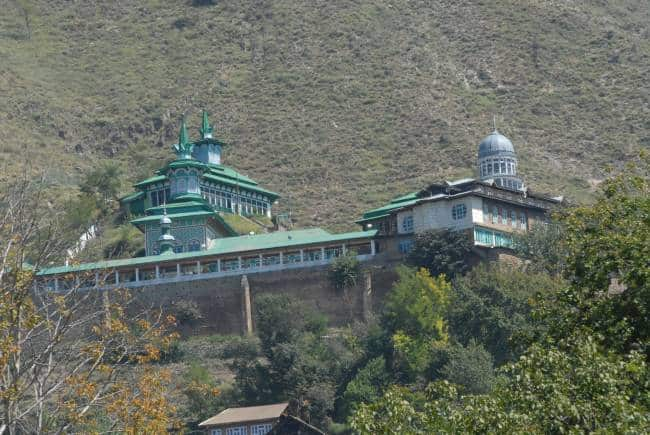 Ashmukam shrine.
Ashmukam shrine.
Nestled in a hillock of south Kashmir Aishmuqam shrine is one of the historical shrines in Kashmir built after famous Sufi saint Sheikh Zain-ud-din Wali who lived in the 15th century AD.
Overlooking the amazing Lidder Valley the shrine of Wali, 20 km from the famous Pahalgam tourist resort in Anantnag district is only 19 km away from the famous hill resort Pahalgam.
To reach the mausoleum located inside a deep cave atop the hill devotees climb on the stone stair with 272 steps. Inside the cave only a few pilgrims can stand at a time to see the relics of the Sufi saint. Inside a deep and narrow cave, some of the important relics being ‘The Rod of Staff’ of Prophet Moses.
An annual Urs is held every year in April when torch lights called “Zool” are lit. The Urs has attracted not just devotees but also tourists who watch mystical dambaali’ and ‘Zool’ festival on the occasion.
Aishmuqam shrine also became an attractive destination for tourists after a Bollywood hit movie Bajrangi Bhaijaan (2015) starring Salman Khan’s qawwali Bhar de Jholi was shot around the shrine.
Discover the latest Business News, Sensex, and Nifty updates. Obtain Personal Finance insights, tax queries, and expert opinions on Moneycontrol or download the Moneycontrol App to stay updated!
Find the best of Al News in one place, specially curated for you every weekend.
Stay on top of the latest tech trends and biggest startup news.